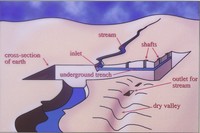Afrikaans8
 2008.08.19 2008.08.19
|
|
0 0
380
|
 Az etruszkok föld_alatti_öntözőcsatornái Az etruszkok föld_alatti_öntözőcsatornái
Etruscans were highly skilled engineers who managed a diverse territory that included mountainous, dry, rocky, and swampy terrain. They used their expertise to build a complex system of roads, many of which are still in existence. They also built elaborate wide-span bridges from interlocking wooden planks reinforced at both ends with rock pillars.
The most remarkable engineering feat of the Etruscans was the cuniculus (pronounced kew-NIK-yoo-luss), a multi-use irrigation trench. The cuniculus consisted of an underground trench cut at a slight incline into the earth, with a series of vertical shafts cut downward to join the trench and spaced roughly 30 yards apart. As the Etruscans population increased and farming became sophisticated, the cuniculus was used as an irrigation device. A cuniculus would be cut perpendicular to a flowing stream, bisecting it. The water from the stream would be diverted into the inclined trench through an inlet, would rise to the openings of the vertical shafts, and then overflow, watering the fry land marked out for agriculture. The last shaft in the row was connected to an outlet, leading to a dry valley. The outlet allowed the water to continue flowing into the dry valley, creating a new stream. Cuniculi were also used to drain waterlogged soil, and as conduits to carry water to larger Etruscan cities. Cuniculi were the forerunners of the Roman aqueducts and sewage systems.
|
|